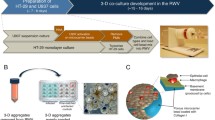Abstract
Intestinal epithelial organoids reflect the morphology and function of an in vivo epithelial barrier. The composition of epithelial cell types reflects the cellular composition of the original tissue (small or large intestine) and organoids can be grown from different species. Thus, intestinal organoids constitute an ideal model to investigate infections of different hosts with enteric pathogens. In this chapter, we will focus on Salmonella infection of human and mouse colonoids grown in a 2D monolayer on permeable filter supports.
Access this chapter
Tax calculation will be finalised at checkout
Purchases are for personal use only
Similar content being viewed by others
References
Molinaro A, Becattini B, Solinas G (2020) Insulin signaling and glucose metabolism in different hepatoma cell lines deviate from hepatocyte physiology toward a convergent aberrant phenotype. Sci Rep 10:12031. https://doi.org/10.1038/s41598-020-68721-9
Hare D, Collins S, Cuddington B, Mossman K (2016) The importance of physiologically relevant cell lines for studying virus–host interactions. Viruses 8. https://doi.org/10.3390/v8110297
Bar-Ephraim YE, Kretzschmar K, Clevers H (2020) Organoids in immunological research. Nat Rev Immunol 20:279–293. https://doi.org/10.1038/s41577-019-0248-y
Schutgens F, Clevers H (2020) Human organoids: tools for understanding biology and treating diseases. Annu Rev Pathol 15:211–234. https://doi.org/10.1146/annurev-pathmechdis-012419-032611
Dutta D, Clevers H (2017) Organoid culture systems to study host-pathogen interactions. Curr Opin Immunol 48:15–22. https://doi.org/10.1016/j.coi.2017.07.012
Sato T, Vries RG, Snippert HJ et al (2009) Single Lgr5 stem cells build crypt-villus structures in vitro without a mesenchymal niche. Nature 459:262–265. https://doi.org/10.1038/nature07935
Haber AL, Biton M, Rogel N et al (2017) A single-cell survey of the small intestinal epithelium. Nature 551:333–339. https://doi.org/10.1038/nature24489
van der Hee B, Madsen O, Vervoort J et al (2020) Congruence of transcription programs in adult stem cell-derived jejunum organoids and original tissue during long-term culture. Front Cell Dev Biol 8:375. https://doi.org/10.3389/fcell.2020.00375
Suwandi A, Galeev A, Riedel R et al (2019) Std fimbriae-fucose interaction increases Salmonella-induced intestinal inflammation and prolongs colonization. PLoS Pathog 15:e1007915. https://doi.org/10.1371/journal.ppat.1007915
Miyoshi H, Stappenbeck TS (2013) In vitro expansion and genetic modification of gastrointestinal stem cells in spheroid culture. Nat Protoc 8:2471–2482. https://doi.org/10.1038/nprot.2013.153
Acknowledgments
E.C.B is funded by R2N, Federal State of Lower Saxony, Germany. G.A.G. is supported by the Deutsche Forschungsgemeinschaft (DFG) priority program SPP1656/2, the German Federal Ministry of Education and Research (BMBF) Infect-ERA consortium grant 031L0093B and DFG collaborative research center SFB 900 TP08 (Project number 158989968).
Author information
Authors and Affiliations
Corresponding author
Editor information
Editors and Affiliations
Ethics declarations
Mouse tissue for Fig. 1 was obtained from animals in accordance with the German Animal Protection Law and were approved by the Lower Saxony State Office for Consumer Protection and Food Safety animal care and use committee (approval # 2015/104). Approval for the use of human tissue for Figs. 1 and 2 was obtained by the Ethics committee of the Hannover Medical School and patients gave their informed consent (approval# 3082–2016).
Rights and permissions
Copyright information
© 2022 The Author(s), under exclusive license to Springer Science+Business Media, LLC, part of Springer Nature
About this protocol
Cite this protocol
Boyle, E.C., Wunschel, E.J., Grassl, G.A. (2022). Salmonella enterica Infection of Human and Mouse Colon Organoid-Derived Monolayers. In: Gal-Mor, O. (eds) Bacterial Virulence. Methods in Molecular Biology, vol 2427. Humana, New York, NY. https://doi.org/10.1007/978-1-0716-1971-1_13
Download citation
DOI: https://doi.org/10.1007/978-1-0716-1971-1_13
Published:
Publisher Name: Humana, New York, NY
Print ISBN: 978-1-0716-1970-4
Online ISBN: 978-1-0716-1971-1
eBook Packages: Springer Protocols




